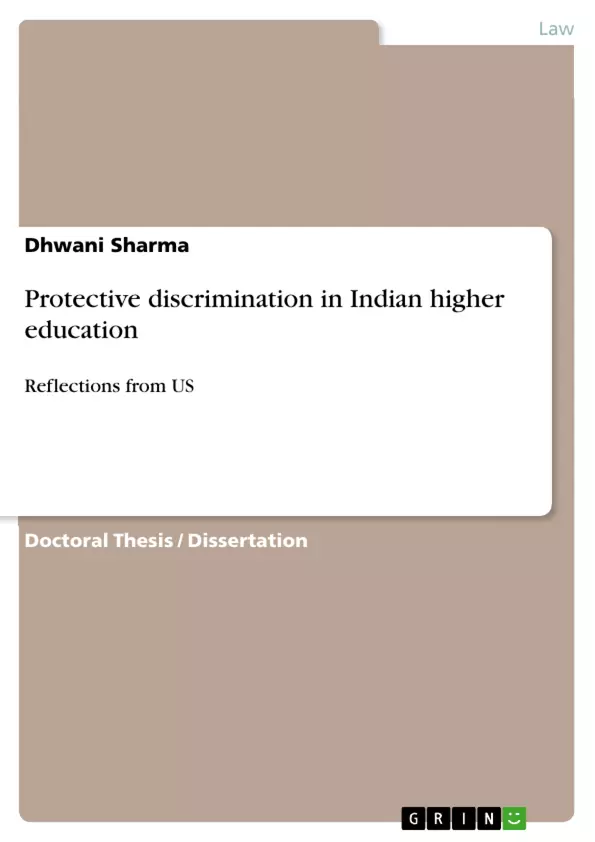
Protective discrimination in Indian higher education
Doktorarbeit / Dissertation, 2014
256 Seiten, Note: NA
Leseprobe
Table of Contents
- Chapter 1 Introduction
- Chapter 2 Promotion of social justice
- Chapter 3 Preferential policy and juristic work
- Chapter 4 Promotion of preferential policy-legal approach in India and U.S.A
- Chapter 5 Preferential policy and judicial response
- Chapter 6 Assessing Educational Access
- Chapter 7 Assessing Competitive Positioning
Objectives and Key Themes
This work aims to analyze the implementation and impact of preferential policies, specifically affirmative action in Indian higher education, examining its effectiveness in promoting social justice. It critically assesses the legal frameworks, judicial responses, and practical consequences of these policies.
- The historical context of social inequality in India and the constitutional mandate for social justice.
- The legal framework governing preferential policies in India, including constitutional provisions and subsequent legislation.
- Judicial interpretations and challenges to preferential policies in India.
- Assessment of the impact of preferential policies on educational access and competitive positioning.
- Comparative analysis of preferential policies in India and the USA.
Chapter Summaries
Chapter 1 Introduction: This chapter sets the stage by outlining the historical context of social inequality in India stemming from its traditional hierarchical system. It highlights the constitutional aim of creating an egalitarian society and the subsequent implementation of preferential policies—reservations in government employment and education—intended to address historical injustices and promote social justice for disadvantaged groups. The chapter introduces the complexities of this policy, including its political ramifications and the ongoing debates surrounding its effectiveness and unintended consequences.
Chapter 2 Promotion of social justice: This chapter delves deeper into the constitutional basis for affirmative action in India. It examines the directive principles of state policy that mandate the government to take measures to prevent social injustice and discrimination. The chapter analyzes the interplay between the principles of equality and the need to address historical inequalities, examining how preferential policies attempt to balance “equality of law” and “equality of fact.” It discusses the conceptualization of protective discrimination as a tool for human rights protection.
Chapter 3 Preferential policy and juristic work: This chapter focuses on the legal and jurisprudential aspects of preferential policies. It explores the specific articles within the Indian Constitution related to affirmative action, particularly Article 16(4) regarding representation in government jobs and Article 15(4) concerning educational opportunities for backward classes. The chapter also analyzes the role of judicial review in shaping the implementation and interpretation of these policies and highlights the tension between affirmative action and principles of merit and efficiency.
Chapter 4 Promotion of preferential policy-legal approach in India and U.S.A: This chapter provides a comparative analysis of preferential policies in India and the USA, examining the similarities and differences in their legal frameworks, implementation strategies, and societal impacts. By contrasting the two systems, it aims to illuminate the challenges and successes of each approach in addressing social inequality. It likely covers different legal interpretations and societal responses to affirmative action.
Chapter 5 Preferential policy and judicial response: This chapter details the judicial history surrounding preferential policies in India. It analyzes landmark court cases and the evolution of judicial interpretations of relevant constitutional provisions. The chapter focuses on how judicial decisions have shaped the application of affirmative action, particularly the ongoing debates about the criteria for determining backwardness and the scope of reservations. It examines the challenges posed by legal challenges to reservation policies and their implications.
Chapter 6 Assessing Educational Access: This chapter assesses the impact of preferential policies on educational access for disadvantaged groups in India. It evaluates the extent to which these policies have expanded opportunities for students from marginalized communities to enroll in higher education, particularly professional programs. The chapter likely utilizes quantitative and qualitative data to analyze the successes and shortcomings of affirmative action in achieving equitable access to education.
Chapter 7 Assessing Competitive Positioning: This chapter examines the impact of preferential policies on the competitive positioning of beneficiaries and non-beneficiaries in higher education and the job market. It analyzes whether affirmative action has led to improved outcomes for beneficiaries without creating significant disadvantages for other groups. The chapter likely examines the complexities of balancing the goals of social justice with concerns about merit and fairness.
Keywords
Protective discrimination, affirmative action, Indian higher education, social justice, constitutional law, judicial review, reservation policy, educational access, competitive positioning, social inequality, legal frameworks, comparative analysis, India, USA.
Frequently Asked Questions: A Comprehensive Language Preview
What is the main topic of this language preview?
This preview summarizes a work analyzing the implementation and impact of preferential policies, specifically affirmative action in Indian higher education. It examines the policy's effectiveness in promoting social justice, critically assessing legal frameworks, judicial responses, and practical consequences.
What are the key themes explored in this work?
Key themes include the historical context of social inequality in India, the legal framework governing preferential policies (including constitutional provisions and legislation), judicial interpretations and challenges to these policies, the impact on educational access and competitive positioning, and a comparative analysis with the USA.
What chapters are included, and what do they cover?
The preview outlines seven chapters: Chapter 1 provides an introduction to social inequality in India and the rationale behind preferential policies. Chapter 2 delves into the constitutional basis for affirmative action. Chapter 3 focuses on the legal and jurisprudential aspects. Chapter 4 offers a comparative analysis with the USA. Chapter 5 details the judicial history surrounding preferential policies in India. Chapter 6 assesses the impact on educational access. Finally, Chapter 7 examines the impact on competitive positioning.
What is the objective of this research?
The research aims to analyze the implementation and impact of preferential policies in Indian higher education, specifically focusing on their effectiveness in promoting social justice. It seeks to critically assess the legal, judicial, and practical aspects of these policies.
What is the significance of the comparative analysis with the USA?
The comparison with the USA's approach to affirmative action helps to illuminate the challenges and successes of different strategies in addressing social inequality, highlighting similarities and differences in legal frameworks, implementation, and societal impact.
What are the key legal aspects discussed in the preview?
The preview discusses crucial legal aspects, including relevant articles within the Indian Constitution (like Articles 16(4) and 15(4)), the role of judicial review in shaping policy interpretation, and the ongoing debates about criteria for determining backwardness and the scope of reservations.
How is the impact of preferential policies assessed?
The impact is assessed through an examination of educational access for disadvantaged groups, evaluating the extent to which policies expanded opportunities for higher education. It also analyzes the impact on the competitive positioning of beneficiaries and non-beneficiaries in education and the job market, considering both successes and potential drawbacks.
What are some key words associated with this work?
Key words include: Protective discrimination, affirmative action, Indian higher education, social justice, constitutional law, judicial review, reservation policy, educational access, competitive positioning, social inequality, legal frameworks, comparative analysis, India, USA.
What type of data is likely used in the research?
The research likely utilizes both quantitative and qualitative data to analyze the impact of affirmative action on educational access and competitive positioning.
For whom is this research intended?
This research is intended for academic use, facilitating the analysis of themes in a structured and professional manner.
Details
- Titel
- Protective discrimination in Indian higher education
- Untertitel
- Reflections from US
- Hochschule
- Bangalore University / Central College (National Law School of India University Bangalore)
- Veranstaltung
- Ph.D.
- Note
- NA
- Autor
- Ph.D. Dhwani Sharma (Autor:in)
- Erscheinungsjahr
- 2014
- Seiten
- 256
- Katalognummer
- V334985
- ISBN (eBook)
- 9783656989479
- ISBN (Buch)
- 9783656989486
- Dateigröße
- 2102 KB
- Sprache
- Englisch
- Schlagworte
- protective indian reflections
- Produktsicherheit
- GRIN Publishing GmbH
- Preis (Ebook)
- US$ 43,99
- Preis (Book)
- US$ 57,99
- Arbeit zitieren
- Ph.D. Dhwani Sharma (Autor:in), 2014, Protective discrimination in Indian higher education, München, Page::Imprint:: GRINVerlagOHG, https://www.diplomarbeiten24.de/document/334985
- Autor werden
- Ihre Optionen
- Vertriebskanäle
- Premium Services
- Autorenprofil
- Textarten und Formate
- Services für Verlage, Hochschulen, Unternehmen

- © GRIN Publishing GmbH.
- Alle Inhalte urheberrechtlich geschützt. Kopieren und verbreiten untersagt.
- info@grin.com
- AGB
- Open Publishing
Der GRIN Verlag hat sich seit 1998 auf die Veröffentlichung akademischer eBooks und Bücher spezialisiert. Der GRIN Verlag steht damit als erstes Unternehmen für User Generated Quality Content. Die Verlagsseiten GRIN.com, Hausarbeiten.de und Diplomarbeiten24 bieten für Hochschullehrer, Absolventen und Studenten die ideale Plattform, wissenschaftliche Texte wie Hausarbeiten, Referate, Bachelorarbeiten, Masterarbeiten, Diplomarbeiten, Dissertationen und wissenschaftliche Aufsätze einem breiten Publikum zu präsentieren.
Kostenfreie Veröffentlichung: Hausarbeit, Bachelorarbeit, Diplomarbeit, Dissertation, Masterarbeit, Interpretation oder Referat jetzt veröffentlichen!
- GRIN Verlag GmbH
-
- Nymphenburger Str. 86
- 80636
- Munich, Deutschland
- +49 89-550559-0
- +49 89-550559-10
- info@grin.com
-









